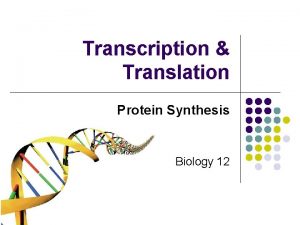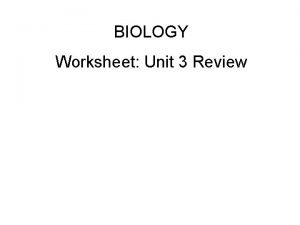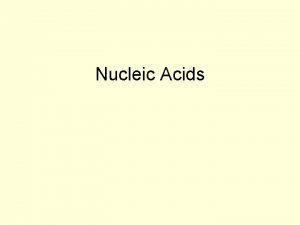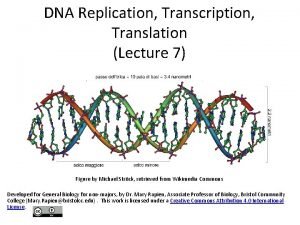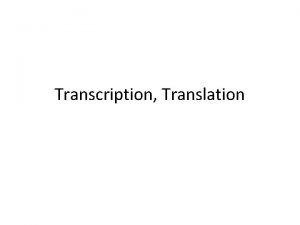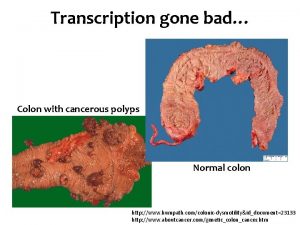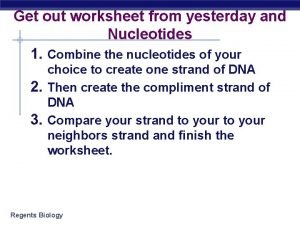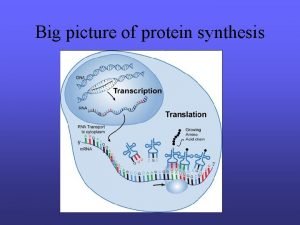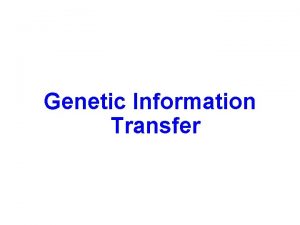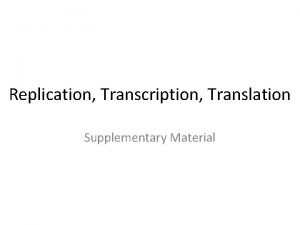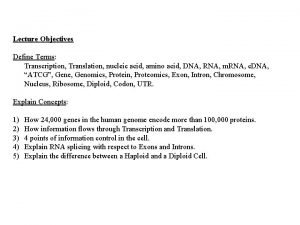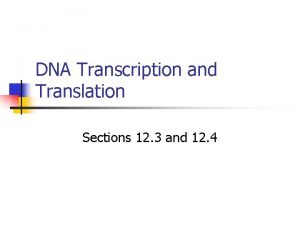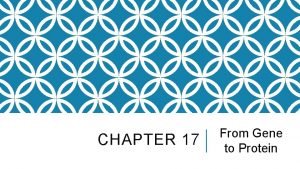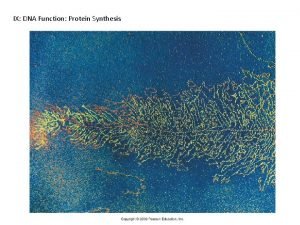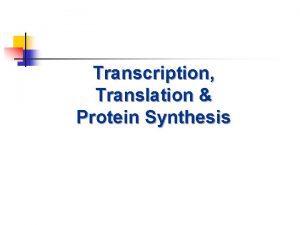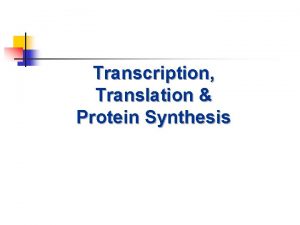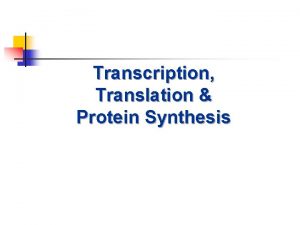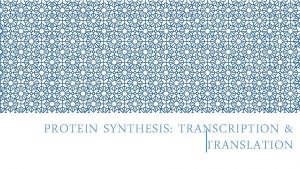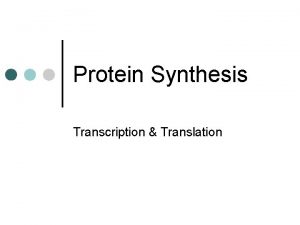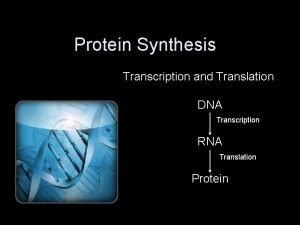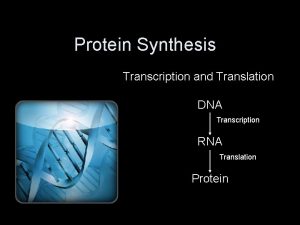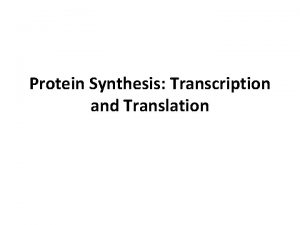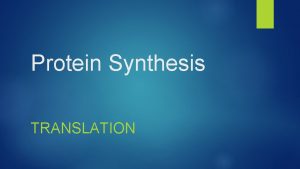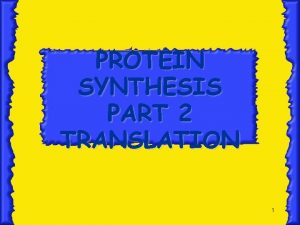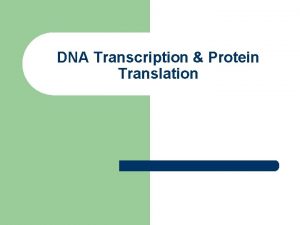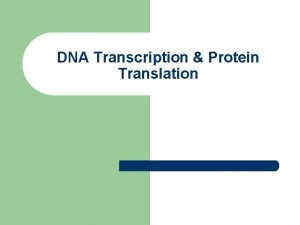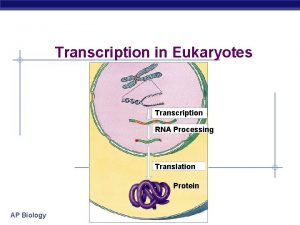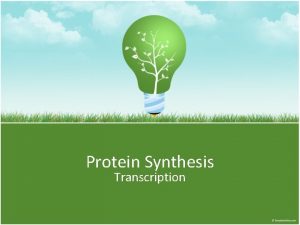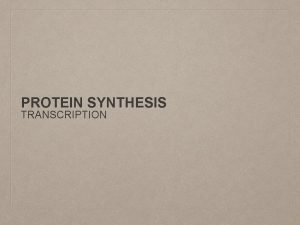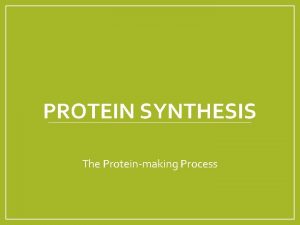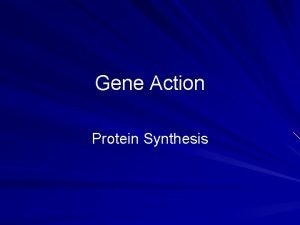Transcription Translation From Gene to Protein protein synthesis


























- Slides: 26

Transcription/ Translation From Gene to Protein (protein synthesis)

• Transcription Protein is made outside of the nucleus at the ribosome, but DNA can’t leave the nucleus. • Transcription - is the making of m. RNA from DNA. • messenger RNA (Ribo Nucleic Acid) is a copy of DNA that can leave the nucleus.

• • • m. RNA is single stranded m. RNA contains no T’s (thymine) It replaces that T’s with U’s (uracil) It can leave the nucleus. It’s base pairs are read it sets of 3 called codons. • A-T-G • U-A-C C-G-G G-C-C T-T-A A-A-U DNA m. RNA

Transcription in Three stages • The three stages of transcription: – Initiation – starting transcription – Elongation – laying down the m. RNA nucleotides – Termination – finalizing the m. RNA

Promoter • Promoter – the beginning of the DNA sequence to be copied. (RNA polymerase II attaches at the promoter) • TATA Box – the promoter begins with a sequence of DNA that includes the base pairs T and A.

Transcription Factors • Transcription Factors – Proteins that allow the RNA Polymerase II to bind to the promoter.

Transcription Initiation Complex • Transcription initiation complex – the promoter, RNA Polymerase II, and Transcription factors all combined and ready to start transcription.

RNA Polymerase • RNA Polymerase – enzyme that unwinds DNA and lays down RNA nucleotides.


Termination • A termination code caused the m. RNA to be cut free from the DNA. (ex. AAUAAA)** • At this point the m. RNA is pre-m. RNA is needs a few modifications

Alteration of m. RNA • The 5 end receives a modified 5 cap – a modified guanine nucleotide with 3 phosphate groups • The 3 end gets a poly-A tail – several adenine nucleotides in a row (50+) • These modifications have several functions: – They allow m. RNA to leave the nucleus – They protect m. RNA from hydrolytic enzymes – They help ribosomes attach to the 5 end

Eukaryotic RNA Splicing • Finally, the sections of the pre-m. RNA that will not be used to code for the protein are cut out. • introns – section that are cut of the pre-m. RNA • exons –sections that are left in the finalized m. RNA

Fig. 17 -10 5 Exon Intron 3 Pre-m. RNA 5 Cap Poly-A tail 1 30 31 Coding segment m. RNA 5 Cap 1 5 UTR 104 105 146 Introns cut out and exons spliced together Poly-A tail 146 3 UTR

Spliceosomes • Spliceosomes – carry out RNA splicing • Made of ribonucleoproteins (sn. RNPs) that recognize the splice sites

Ribozymes • Ribozymes -are catalytic RNA molecules that function as enzymes and can splice RNA (present in sn. RNP’s) (ribozyme)

Alternative RNA splicing • alternative RNA splicing – choosing different regions of introns or exons from the same prem. RNA sequence • So one gene can code for more than one protein.

t. RNA • • t-RNA – Transfer RNA (single stranded) Each t. RNA has an anti-codon that matches up with a codon on the messenger RNA Each t. RNA also has a particular amino acid attached to it.

Amino Acids • Each t. RNA also has a particular amino acid attached to it. • aminoacyl-t. RNA synthetase – enzyme that attaches amino acids to t. RNA


Ribosomes • Ribosomes match the t. RNA anticodons with m. RNA codons in protein synthesis • The two ribosomal subunits are made of proteins and ribosomal RNA (r. RNA) • small subunit holds m. RNA • Large subunit holds the t. RNA

Building a Polypeptide • A ribosome has three binding sites for t. RNA: – A site- holds the t. RNA that carries the next amino acid to be added to the chain – P site- holds the t. RNA that carries the growing polypeptide chain – E site- is the exit site, where discharged t. RNAs leave the ribosome. ** P A

Fig. 17 -17 3 U A C 5 Met 5 A U G 3 Initiator t. RNA P site Met Large ribosomal subunit GTP GDP E m. RNA 5 Start codon m. RNA binding site 3 Small ribosomal subunit 5 A 3 Translation initiation complex

Fig. 17 -18 -4 Amino end of polypeptide E 3 m. RNA Ribosome ready for next aminoacyl t. RNA P A site 5 GTP GDP E E P A GDP GTP E P A

Polyribosomes • polyribosome (or polysome) -several ribosomes translate a single m. RNA simultaneously, allowing a cell to make many copies of a protein very quickly Copyright © 2008 Pearson Education Inc. , publishing as Pearson Benjamin Cummings

Completing the Protein • signal peptide – a short peptide added to the finished protein. ** • signal-recognition particle (SRP) – attaches to the signal peptide that it may enter the ER.

Predicting Proteins • • Predict the protein DNA = ATG CGG RNA = UAC GCC Prot. = Tyr Ala
 Chapter 17 gene expression from gene to protein
Chapter 17 gene expression from gene to protein Transcription and translation
Transcription and translation Transcription or translation
Transcription or translation Blood type chart
Blood type chart Biology transcription and translation
Biology transcription and translation Dna meaning
Dna meaning Transcription end result
Transcription end result Translation transcription
Translation transcription Replication vs transcription venn diagram
Replication vs transcription venn diagram Transcription and translation practice worksheet answer key
Transcription and translation practice worksheet answer key Dna replication transcription and translation
Dna replication transcription and translation Perbedaan replikasi virus dna dan rna
Perbedaan replikasi virus dna dan rna Picture of protein synthesis
Picture of protein synthesis Replication transcription translation
Replication transcription translation Protein synthesis gcse
Protein synthesis gcse Rna dna venn diagram
Rna dna venn diagram Translation transcription
Translation transcription Transcription translation replication
Transcription translation replication Translation
Translation Dna transcription and translation
Dna transcription and translation Transcription
Transcription Gene by gene test results
Gene by gene test results Chapter 17 from gene to protein
Chapter 17 from gene to protein Chapter 17 from gene to protein
Chapter 17 from gene to protein Protein synthesis and mutations
Protein synthesis and mutations Rna protein synthesis
Rna protein synthesis Protein synthesis
Protein synthesis


